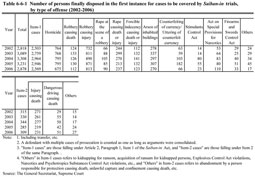| Previous Next Index Image Index Year Selection | |
|
|
The Saiban-in Act promulgated on May 28, 2004 established the Saiban-in system. It is expected that the general public's sound common sense shall be reflected in the contents of trials through their participation widely in the process of criminal trials, which will deepen the general public's understanding and support toward the judiciary and enable the judiciary to obtain a stronger national foundation. The act, excluding a part of provisions, is to be put into force on a date specified by a Cabinet Order within five years from the date of promulgation (by May 27, 2009).
Cases to be covered by Saiban-in trials are, in principle, cases pertaining to offenses punishable by death penalty, life imprisonment with or without work (Item-1 cases), cases which are to be treated under the collegiate court system and pertain to offenses causing death to victims through intentional crime activities (Item-2 cases). At Saiban-in trials, deliberation shall be conducted by a collegial body consisting of three judges and six Saiban-ins (for cases without disputes that meet certain conditions, one judge and four Saiban-ins) for finding facts pertaining to judgment and deciding application of acts and regulations and the appropriate punishment. Verdict shall be made based on opinions of the majority of the collegial body including those of both judges and Saiban-ins (In cases where the majority opinions were those approved only by Saiban-ins as a result of the verdict, the verdict result cannot be made the judgment of the collegial body, as it does not meet this requirement. Such cases shall be treated as those in which existence or non-existence of facts, about which public prosecutors bear the burden of proof, could not be verified.). The flow of selecting Saiban-ins is as follows. A list of Saiban-in candidates selected by lot among those registered as eligible voters shall be made every year by respective district courts. Saiban-in candidates are selected by lot from the list of Saiban-in candidates for respective cases and are summoned to the courts for selection procedures. The courts select Saiban-ins after excluding those with certain disqualification causes, those with employment prohibition causes, those with causes deemed disqualified for cases, those whose refusal is admitted by the court due to certain refusal causes, and those whom a public prosecutor or a defendant requests not to select without presenting any causes. Further, the “Regulation on the Participation of Saiban-ins in Criminal Trials” (Supreme Court Regulation No. 7, July 5, 2007), which defines specific procedures for the selection of Saiban-ins such as a daily allowance, etc. was formulated on June 13, 2007, and promulgated on July 5, 2007. Also, the “Act for Partial Amendment to the Act on the Participation of Saiban-ins in Criminal Trials” (Act No. 60 of 2007), which includes the establishment of a partial judgment system, etc. was enacted on May 22, 2007, and promulgated on 30th of the same month. The partial judgment system, when, under the Saiban-in system, a court is in charge of multiple cases of the same defendant and the cases are consolidated in the trial, allows the cases to be divided into several parts in order to lessen the burden on Saiban-ins. Next, under the collegial-body-member judges who are in charge of all the cases, Saiban-ins are selected for each part of cases, deliberate them, and judge whether or not the defendant is guilty one by one. Then newly selected Saiban-ins and the above judges deliberate cases other than these, and render a final judgment in regard to the entire consolidated cases, with the decision of a sentence in case of guilty, based on prior partial judgments. Table 6-6-1 shows the number of persons finally disposed in the first instance for cases to be covered by Saiban-in trials, by type of offense, over the last five years. Table 6-6-1 Number of persons finally disposed in the first instance for cases to be covered by Saiban-in trials, by type of offense (2002-2006) The number of persons finally disposed in 2006 decreased by 10.9% from the previous year. By type of offense, those finally disposed for robbery causing injury were the largest in number at 813 (28.2%), followed by those for homicide at 675 (23.5%), and those for arson of inhabited buildings at 270 (9.4%).Table 6-6-2 shows sentencing for persons convicted in the first instance in 2006 for cases to be covered by Saiban-in trials, by type of offense. Table 6-6-2 Sentencing in the first instance for cases covered by Saiban-in trials, by type of offense (2006) Among those sentenced to imprisonment with work for over 15 years, 131 persons were sentenced to imprisonment with work for 20 years or less. By type of offense, those for homicide were the largest in number at 61, followed by those for robbery causing injury (30 persons), and those for rape causing death or injury (16 persons). Also, 17 persons were sentenced to imprisonment with work for over 20 years but 25 years or less, 8 persons for homicide, two each for robbery causing death, robbery causing injury, rape at the scene of a robbery and rape causing death or injury, and one for violation of the Firearms and Swords Control Act. 9 persons were sentenced to imprisonment with work for over 25 years, five for robbery causing death, two for rape causing death or injury, and one each for homicide and rape at the scene of a robbery (Source: The General Secretariat, Supreme Court). |

